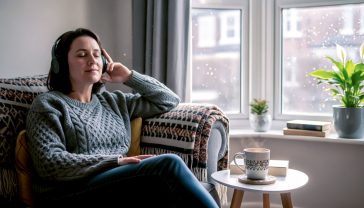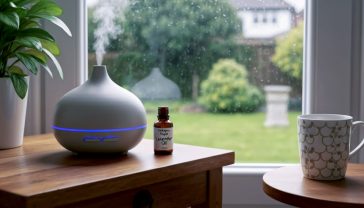The Great British Guide to Lemongrass Oil: 5 Invigorating Uses for a Zestier Home & Happier You
Tired of harsh chemicals? Our ultimate guide for UK readers explores 5 amazing uses for lemongrass oil, from making your home sparkle to soothing knackered muscles.
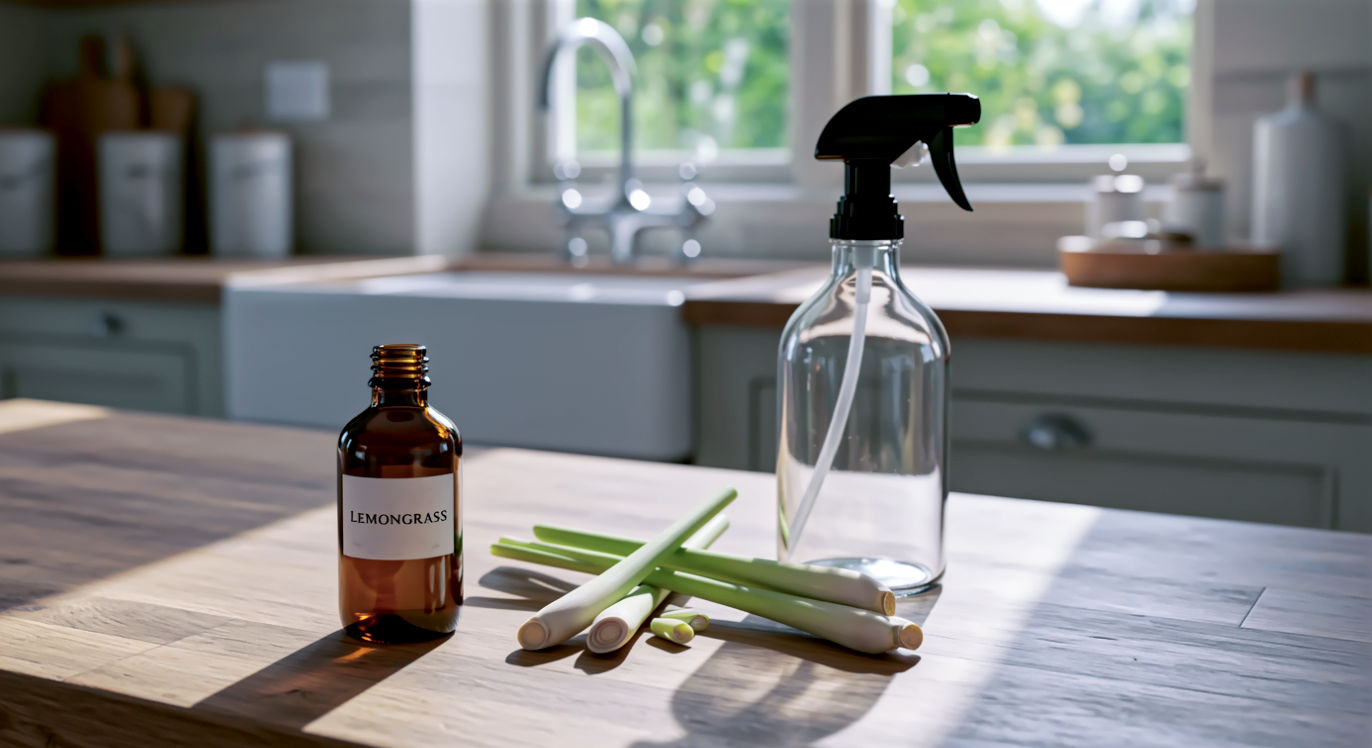
This post may contain affiliate links. If you make a purchase through these links, we may earn a commission at no additional cost to you.
Ever get a whiff of something so fresh, so zesty, and so alive it cuts right through a grey, damp afternoon? Chances are, you might have just met lemongrass. Its sharp, citrusy punch is brighter than a surprise sunny day during Wimbledon, and it’s bottled up in one of the most useful essential oils you can have in your home.
If you’ve ever thought essential oils were just for “woo-woo” wellness or making your nan’s potpourri smell nice, think again. Lemongrass oil is a proper workhorse. It’s a bit of a superpower in a bottle, really—part cleaner, part-mood-booster, part-skin-saver, and part-muscle-soother. It’s the Swiss Army knife of aromatherapy.
But let’s be honest, the world of essential oils can be a bit of a faff. What’s good? What’s dodgy? Will it poison the cat? How do I use it without my house smelling like a giant lemon sweet?
Relax. We’ve got you covered. This is your ultimate, no-nonsense British guide to lemongrass essential oil. We’re going to skip the jargon and give you the real, practical advice. We’ll look at five genuinely invigorating ways to use it, dive into the simple science of why it works, and cover the really important safety bits so you can use it with confidence.
Grab a cuppa. Let’s get stuck in.
What Exactly Is Lemongrass Essential Oil?
First things first, let’s clear up a common mix-up. Despite its name, lemongrass has nothing to do with actual lemons. You can’t slice it up for your gin and tonic—well, you can use the fresh stalks, but the essential oil is a different beast entirely.
Meet the Plant: Not a Lemon, But a Grass
Lemongrass is a tall, scruffy-looking perennial grass that absolutely loves the heat. It grows in big, clumpy bunches in tropical places like India, Sri Lanka, and Thailand. It looks a bit like a bulky, overgrown spring onion, and if you crush one of its grassy leaves, you get that instant, powerful citrusy smell.
For centuries, this plant has been a superstar in traditional medicine, especially in Southeast Asia. It was (and still is) brewed into a tea to help with fevers, aches, pains, and dodgy stomachs. In fact, one of its old folk names is “fever grass”—a pretty good clue to its powerful properties.
How Does a Grassy Stalk Become a Potent Oil?
So, how do they get all that zesty goodness from a tough, fibrous grass into that tiny little bottle? The answer is steam distillation.
It’s a bit like a giant, high-tech kettle.
- Huge vats are packed tight with chopped-up lemongrass leaves and stalks.
- Hot steam is forced through the vat from below.
- This high-pressure steam bursts the tiny, microscopic sacs on the leaves that hold the essential oil.
- The steam, now carrying the oil, rises and travels into a condenser—a big coil of pipes that cools it all down.
- As it cools, the steam turns back into water, and the oil… well, oil and water don’t mix. The bright yellow essential oil floats right on top.
- This oil is then skimmed off, filtered, and bottled.
It takes a massive amount of grass to make a tiny bit of oil. We’re talking hundreds of kilos of plant material for one litre of oil. That’s why 100% pure essential oil is so potent and why you only ever need a few drops.
The Two Main Lads: West Indian vs. East Indian
You might see two different Latin names on bottles. Don’t let it confuse you; it’s pretty simple.
- West Indian Lemongrass (
Cymbopogon citratus): This one is more common in cooking (it’s the one you’ll find in Thai green curry). Its oil is fantastic, but it’s often considered a little softer. - East Indian Lemongrass (
Cymbopogon flexuosus): This is the one you’ll most likely find sold as an essential oil in the UK. It’s grown mostly in India, and its oil is famous for having a very high amount of the “good stuff” we’re about to talk about.
The takeaway for you: Honestly, for home use, either is brilliant. The East Indian (flexuosus) type is slightly more common and is the one most of the scientific studies are based on, so it’s a great one to look for.
The “Science Bit” (Made Simple): What’s in the Bottle?
Right, why does this stuff actually work? It’s not magic, it’s just chemistry. An essential oil is a complex cocktail of natural chemical compounds, and lemongrass has some real winners.
The Star of the Show: Citral
If lemongrass oil were a pop band, citral would be the lead singer. This one compound makes up a whopping 65-85% of the oil. Citral is actually a pair of molecules (isomers, if you want to be fancy) called geranial and neral.
Think of citral as the oil’s left-hook and right-jab. It’s responsible for:
- The Lemony Scent: It’s the main source of that classic smell.
- The Anti-Germ Power: Citral is a proven, powerful antibacterial and antifungal. It’s bad news for bacteria (like E. coli) and fungi (like the stuff that causes athlete’s foot or mould).
- The Calming Vibe: Some studies suggest citral can have a calming, sedative-like effect on the nervous system when inhaled.
This one compound is the reason lemongrass is such a rockstar cleaner and skin-clarifier.
The Supporting Cast: Geraniol & Myrcene
While citral is grabbing the spotlight, a few other compounds are doing important work in the background.
- Geraniol: You also find this in rose and geranium oil. It adds a slightly sweeter, floral note to the scent and pitches in with its own anti-germ and antioxidant properties.
- Myrcene: This one is fascinating. Myrcene is also found in hops (yes, like in beer), mangoes, and thyme. It’s well-known in the science world for its anti-inflammatory (reduces swelling) and analgesic (pain-relieving) effects.
So, when you put it all together, you have a bottle that can fight germs, calm inflammation, and smell absolutely amazing. Now, let’s put it to work.
Use 1: Banish Stale Air & Boost Your Mood
Forget those sickly-sweet plug-in air fresheners. Lemongrass is your natural, grown-up solution to making your home smell incredible.
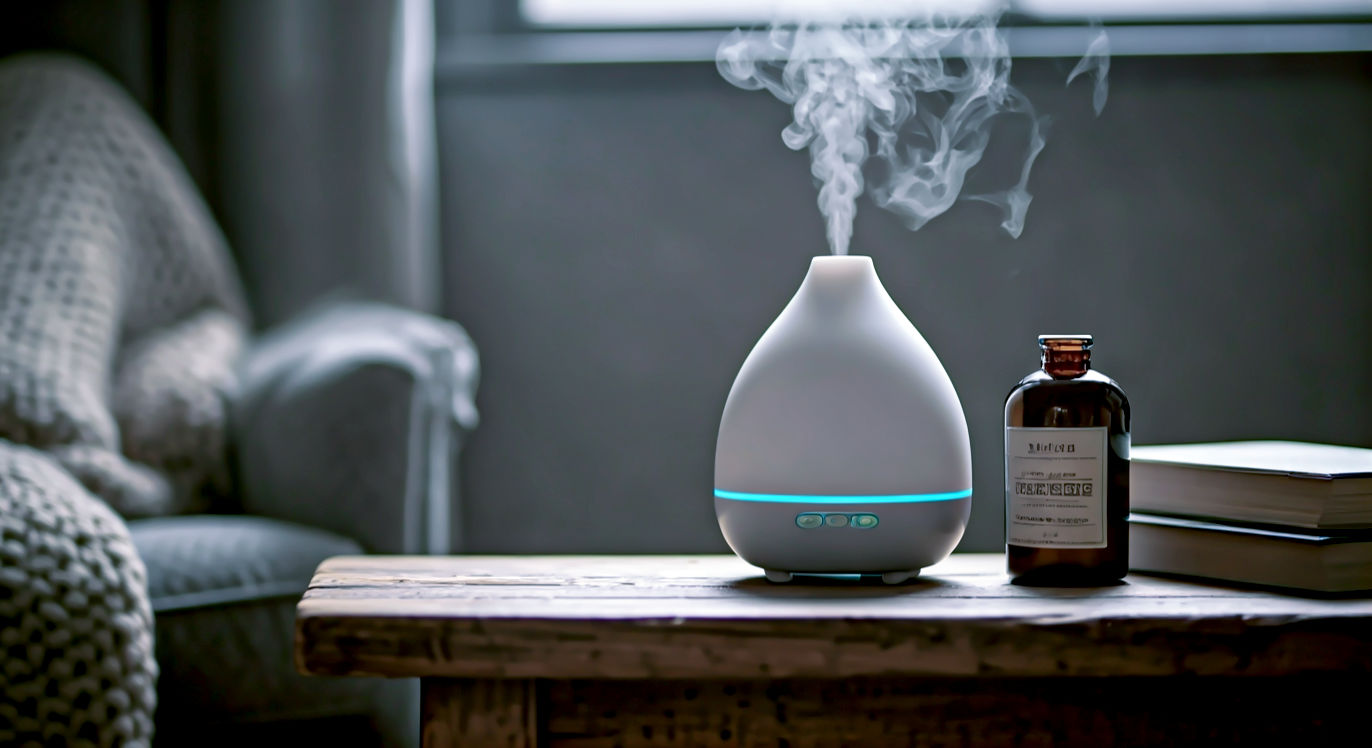
Why It Works Better Than a Tin of “Ocean Breeze”
Most air fresheners just mask bad smells with a stronger, synthetic perfume. Lemongrass essential oil works differently.
- It Neutralises Odours: Thanks to its antibacterial properties, it doesn’t just cover up stale smells—it helps to tackle the bacteria causing them. This makes it brilliant for musty, damp smells (hello, British winter), lingering cooking odours (goodbye, Sunday roast and kippers), or that ‘teenage bedroom’ funk.
- It Genuinely Lifts Your Mood: The scent itself is an aromatherapy powerhouse. It’s an invigorating oil. It’s zesty, bright, and energetic. It’s fantastic for when you’re feeling a bit sluggish, foggy-headed, or just plain fed up.
How to Use It: The Diffuser
This is the easiest way to get started. An ultrasonic diffuser (the kind you add water to) is perfect.
- Method: Fill the diffuser with water to the line. Add 3-5 drops of lemongrass essential oil.
- Top Tip: Start with less. Lemongrass is strong. You can always add another drop, but you can’t easily take one away. It’s better for it to be a subtle, fresh background note than a full-on citrus assault.
DIY Recipe: The “Fresh Start” Room Spray
This is a game-changer for instantly refreshing a room, your sofa cushions, or the car.
You’ll Need:
- A 100ml dark glass spray bottle (dark glass stops sunlight from breaking the oil down)
- About 80ml of distilled or cooled, boiled water
- About 20ml of witch hazel or a cheap, unflavoured vodka (This is the emulsifier—it helps the oil and water to mix. Without it, the oil just floats on top).
- 15-20 drops of Lemongrass essential oil
Method:
- Pour the witch hazel or vodka into your spray bottle first.
- Add the lemongrass essential oil. Give it a swirl to mix.
- Top up the bottle with the water.
- Screw the lid on tight and shake well before every single use.
- Mist it high into the air, onto fabrics (do a little patch test on a hidden spot first!), or into smelly shoes.
Pro-Blend: For a calming-yet-fresh spray, try 10 drops of lemongrass and 10 drops of lavender.
More Quick ‘N’ Easy Freshening Tricks
- For Bins: Put 2-3 drops on a cotton ball and pop it in the bottom of your bin liner.
- For the Hoover: Add 1-2 drops to your hoover’s filter or the inside of the dust bag. The whole house will smell fresh as you clean.
- For the Loo: Put 1-2 drops on the cardboard tube of the toilet roll. Every time it’s used, it’ll release a gentle puff of scent.
Use 2: Make Your Home Sparkle (The Natural Cleaning Hero)
If you’re trying to cut down on harsh chemicals like bleach, lemongrass oil is about to become your best mate. That powerful citral content makes it a mean, green, cleaning machine.
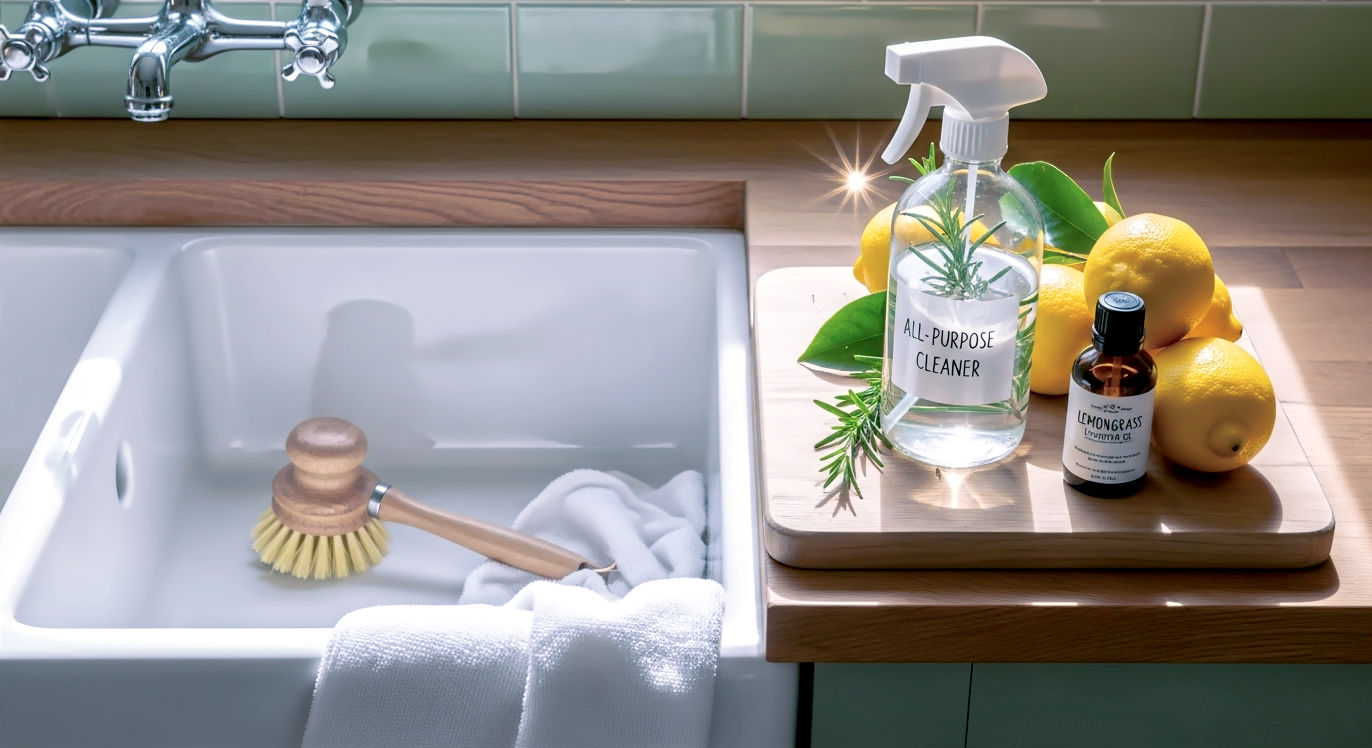
The Germ-Busting Power of Citral
We’re not just guessing here. Scientific studies have shown that lemongrass oil is effective against a whole host of nasty bacteria, including E. coli and Staphylococcus aureus. Its antifungal properties also make it brilliant for tackling mould and mildew in damp-prone areas like the bathroom.
It’s a fantastic, non-toxic way to keep your kitchen counters and bathrooms hygienic and smelling wonderful.
DIY Recipe: All-Purpose “Shine-On” Surface Spray
This is your go-to for worktops, sinks, tiles, and pretty much anything else.
You’ll Need:
- A 500ml glass or PET plastic spray bottle
- 250ml (1 cup) of white vinegar
- 250ml (1 cup) of cooled, boiled water
- 25-30 drops of Lemongrass essential oil
Method:
- Pour all the ingredients into the spray bottle.
- Shake very well before each use.
- Spray onto surfaces and wipe clean with a reusable cloth.
A Really Important Note: Because this contains vinegar, do not use it on natural stone surfaces like granite or marble. The acid can damage and dull the finish. For those, use the room spray recipe (water + vodka/witch hazel + oil) or just soap and water.
DIY Recipe: “Mop & Mingle” Floor Cleaner
This will make your floors (and your whole home) smell divine.
You’ll Need:
- Your mop bucket
- A good glug of hot water
- A splash of white vinegar OR a squirt of liquid castile soap
- 15-20 drops of Lemongrass essential oil
Method:
- Fill your bucket with hot water.
- Add the vinegar (for shine and disinfecting) or soap (for cutting through grime).
- Add the lemongrass oil—it will swirl on the surface, but that’s fine.
- Mop as usual. The smell is absolutely incredible.
Don’t Forget These Grimy Spots…
- Drains: Pour half a cup of bicarbonate of soda down the drain, followed by half a cup of white vinegar. Let it fizz. After 10 minutes, add 5 drops of lemongrass oil and flush it all through with a kettle of hot water.
- The Allotment Shed: Got an old wooden shed that smells a bit… earthy? A lemongrass spray is perfect for cleaning down your tools and shelves, and the oil is a known insect repellent, which is a handy bonus.
Use 3: Clarify Your Skin & Banish Greasy Hair
Lemongrass isn’t just for cleaning your house; it can help “clean up” your skin and hair, too.
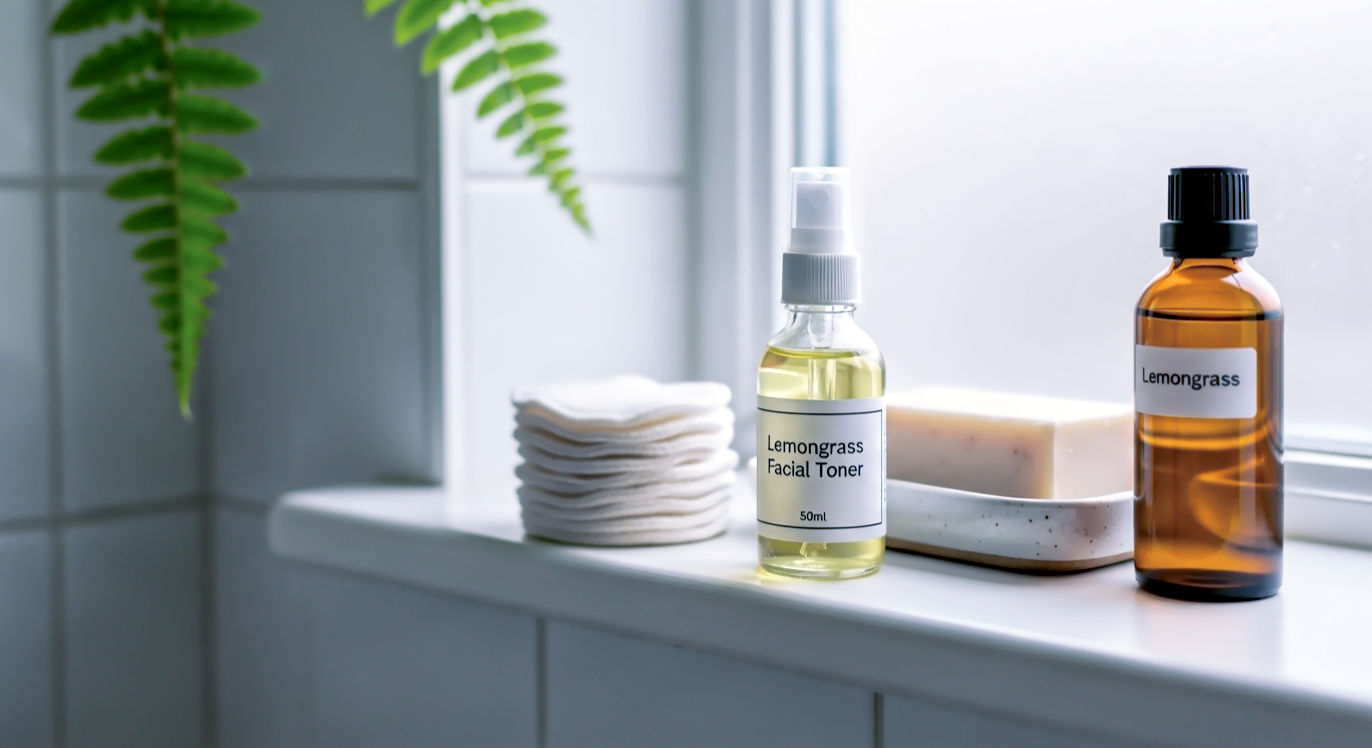
Why It’s Great for Oily Bits
The key property here is astringent. An astringent is something that gently causes the skin to contract or tighten. Think of it as a natural toner. For your face, this means lemongrass oil can help to:
- Temporarily tighten and tone the skin.
- Minimise the appearance of pores.
- Control excess oil (sebum), which leads to that midday shine.
Add in its antibacterial properties, and you can see why it’s a popular ingredient for people with oily or spot-prone skin. It helps keep things clean and balanced.
The Golden Rule: DILUTE. DILUTE. DILUTE.
This is the most important part of this section. You must never, ever put neat essential oil on your skin. Lemongrass is a “hot” oil and is very potent. Putting it on neat can cause irritation, redness, and even chemical burns.
Worse, it can cause sensitisation. This is when your body has a bad reaction and permanently becomes allergic to that oil.
Your Simple Dilution Guide:
- For the Face: A 1% dilution is safest. This means 1 drop of essential oil per 1 teaspoon (5ml) of carrier oil.
- What’s a Carrier Oil? It’s a plain, fatty oil that “carries” the essential oil safely onto your skin. Good choices for the face include jojoba (which is brilliant for oily skin), grapeseed, or sweet almond oil.
DIY Recipe: Simple Clarifying Facial Toner
You’ll Need:
- A small (50ml) bottle
- Alcohol-free witch hazel
- 1-2 drops of Lemongrass essential oil
Method:
- Fill the bottle almost to the top with witch hazel.
- Add your 1-2 drops of lemongrass oil.
- Shake very well before each use.
- After cleansing, pop a little onto a reusable cotton pad and wipe over your face, avoiding the delicate eye area.
CRUCIAL STEP: Before you put this anywhere near your face, do a patch test. Mix 1 drop of oil in 1 tsp of carrier oil. Dab a tiny amount behind your ear or on your inner elbow. Wait 24-48 hours. If there’s no redness, itching, or irritation, you’re good to go.
DIY Recipe: “Grease-Be-Gone” Scalp Tonic
This same oil-balancing, antifungal magic works wonders on greasy scalps and dandruff (which is often caused by a fungus).
Method 1: The Shampoo Hack
- Do NOT add oil to your whole shampoo bottle. It won’t mix and will mess up the preservatives.
- Instead, squeeze your normal amount of shampoo into your palm. Add one single drop of lemongrass oil. Mix it together in your hand and then shampoo as normal. Rinse very well.
Method 2: The Pre-Wash Scalp Oil
- You’ll Need: 2 tablespoons (30ml) of a light carrier oil like jojoba or argan oil.
- Add 5-6 drops of lemongrass oil and mix well.
- Part your hair and massage this oil directly into your scalp (not the lengths of your hair).
- Pop on a shower cap (or just wrap your head in a towel you don’t mind getting oily) and leave it for 30 minutes.
- Shampoo out thoroughly. You might need to shampoo twice.
Use 4: Soothe Knackered Muscles & Achy Bits
Had a brutal day in the garden? Hiked up a hill? Or just stiff from sitting hunched over your laptop? Lemongrass can help.
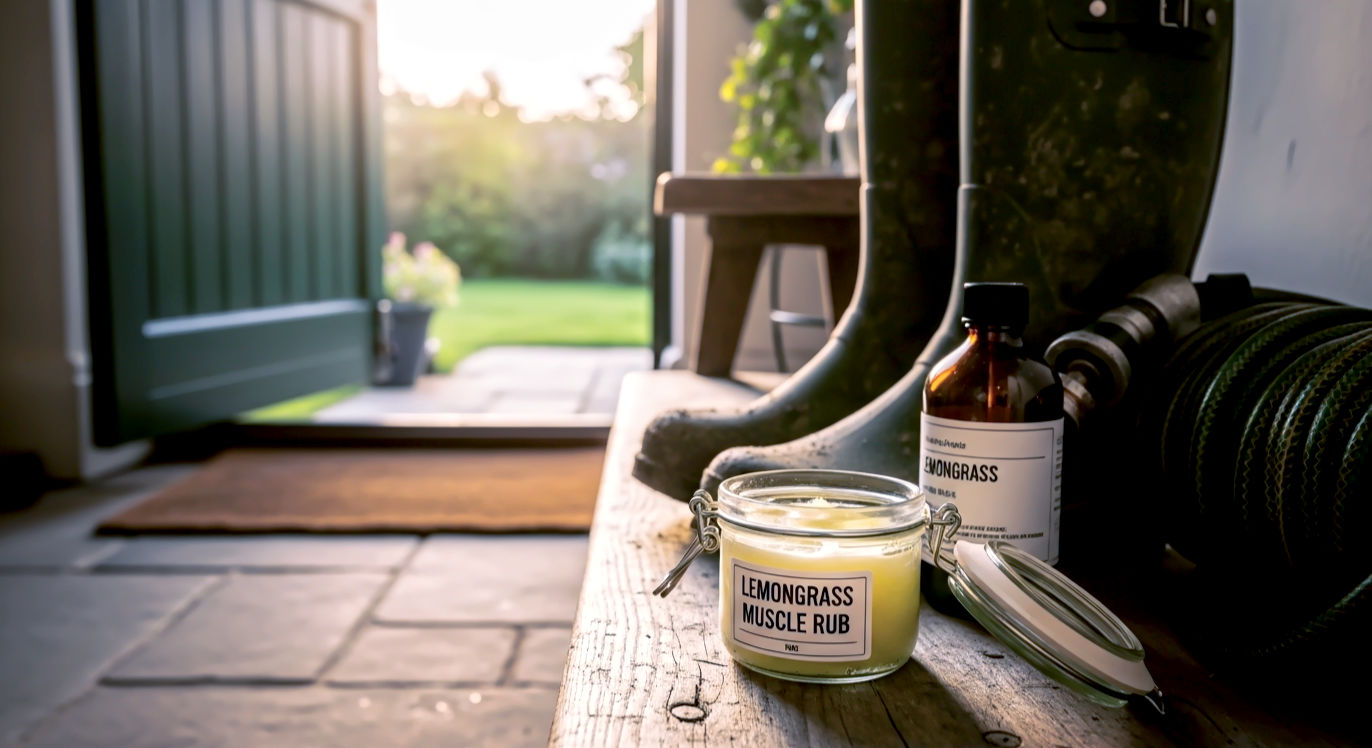
How Can a Smell Help My Aching Knees?
It’s not just the smell! Remember myrcene and geraniol? These compounds are known to be anti-inflammatory (calm down swelling) and analgesic (help to relieve pain).
When you massage the diluted oil into a sore muscle, you’re doing two things:
- The massage itself helps to boost circulation and warm the area.
- The active compounds in the oil get to work on the inflammation and pain receptors.
It’s a brilliant natural alternative to those smelly, chemically heat rubs, and it’s perfect for soothing overworked muscles, stiff joints, and general aches.
DIY Recipe: “Post-Hike” Muscle Rub
This is what you’ll want after a long day on your feet.
You’ll Need:
- A small bottle or jar
- 30ml (2 tablespoons) of a carrier oil. Grapeseed or sweet almond oil are great as they sink in well.
- 15 drops of Lemongrass essential oil (This is a 2.5% dilution, which is fine for short-term use on the body, but not the face).
Method:
- Mix the oils together and store in your dark bottle.
- Scoop or pour a small amount into your hands and massage deeply into knackered calves, sore shoulders, an aching lower back… wherever it hurts.
Pro-Tip: Make a “Power Blend”
Lemongrass plays really well with other “achy” oils. For an even more powerful rub, try this blend in your 30ml of carrier oil:
- 7 drops of Lemongrass (for pain and inflammation)
- 5 drops of Lavender (for calming and soothing)
- 3 drops of Peppermint (for a cooling, tingling sensation that’s amazing on muscles)
What About Headaches?
Lemongrass is a traditional remedy for headaches, and it often works. The pain-relieving properties and the way it can relax tense muscles (like in your neck and temples) are a big help.
Method:
- Mix one single drop of lemongrass oil with 1 teaspoon (5ml) of carrier oil.
- Very gently massage a tiny amount onto your temples (stay well away from your eyes!), the back of your neck, and your shoulders.
- Breathe deeply.
Use 5: De-Frazzle Your Brain & Find Your Focus
This final use is all about your mind. We’ve talked about how the scent is “uplifting,” but we can use that power deliberately.
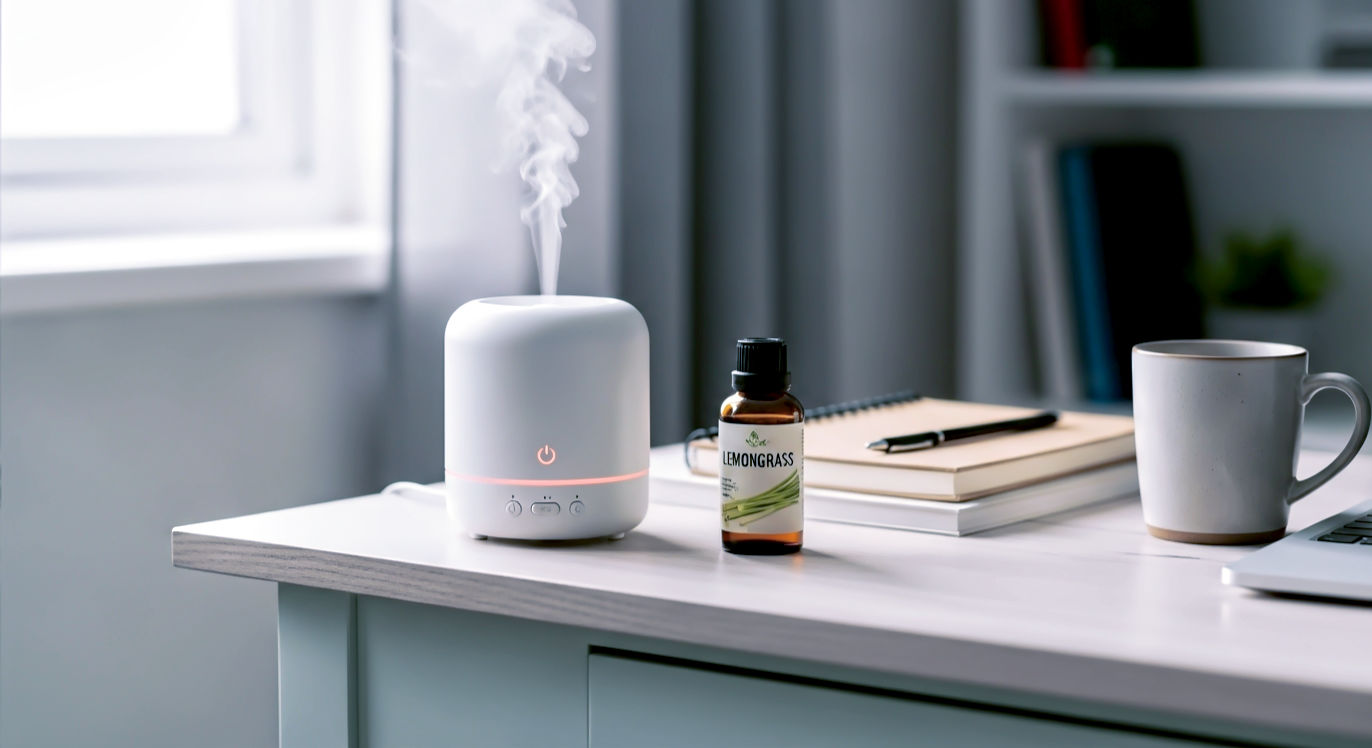
Zesty, Not Zzzzz…
Unlike lavender, which is famous for lulling you to sleep, lemongrass is a “wakey-wakey” oil. It’s invigorating. It’s sharp, green, and clean, and it works like a charm to cut through mental fog and tiredness.
Analogy: If lavender is a warm, milky drink before bed, lemongrass is a cold, crisp splash of water to the face. It demands your attention (in a good way).
The Science of Scent (Aromatherapy)
This isn’t just imagination. Your sense of smell (your olfactory system) is wired directly into your limbic system—the oldest part of your brain, which controls your emotions, memory, and instincts.
When you inhale lemongrass, those citral molecules hit receptors in your nose and send a direct signal to your brain that says “Alert! Fresh! Focus!” Small studies have shown it can help reduce feelings of anxiety and tension, leaving you feeling calmer but more switched-on.
How to Use It for Your Mind
- The ‘Desk Diffuser’: This is the number one use for WFH (Work From Home). When that 3 PM slump hits, and you’re reaching for your fourth biscuit, put 3-4 drops in your diffuser. It’s amazing for helping you power through the last bit of the day.
- The ‘Inhaler Stick’: You can buy blank ‘aromatherapy inhaler’ sticks online. Add 5-10 drops to the cotton wick, and you have a personal, portable pick-me-up you can sniff at your desk or on the train without bothering anyone else.
- The ‘Shower Shock’: Put 2-3 drops on the floor of your shower, just out of the direct spray. The steam will rise with the oil, creating an instant, invigorating steam room that will wake you up properly.
DIY Recipe: “Get It Done” Diffuser Blend
Want to get in the zone? Try this blend in your diffuser.
- 3 drops of Lemongrass (for that zesty focus)
- 2 drops of Rosemary (famously known as the “oil of remembrance” and great for concentration)
- 2 drops of Lemon (to add even more clean, bright energy)
How to Buy The Good Stuff (And Not Get Ripped Off)
The essential oil market is full of fakes. A lot of what’s sold in discount shops or on dodgy websites is just cheap synthetic fragrance, not the real deal. Here’s how to be a smart buyer.
Your Smart-Buyer’s Checklist
- Look for the Latin Name: This is the most important clue. The bottle must say
Cymbopogon flexuosusorCymbopogon citratus. If it just says “Lemongrass Fragrance Oil,” put it down. - Check the Bottle: It must be in a dark glass bottle (usually amber or blue). Light and heat destroy essential oils, so a clear plastic bottle is a massive red flag.
- Read the Ingredients: The label should say “100% Pure Lemongrass Essential Oil.” Nothing else. No “sunflower oil,” no “parfum,” no “fragrance blend.”
- Mind the Price: If a 10ml bottle is £1, it’s not real. It takes a huge amount of plant to make that oil. You should expect to pay a fair price for it. It doesn’t have to be the most expensive, but it shouldn’t be suspiciously cheap.
- Buy from a Reputable Seller: Your best bet is to buy from a specialist aromatherapy company. In the UK, look for brands that are members of the Aromatherapy Trade Council (ATC). This shows they stick to high standards. Health food shops are usually a much safer bet than a gift shop.
The Really, Really Important Safety Guide
This is the most important section of the whole article. Lemongrass oil is amazing, but it is powerful, concentrated stuff. Please treat it with respect.
Rule 1: Always, Always Dilute
We’ve said it before, and we’ll say it again. Do not use neat essential oil on your skin. It can and does cause irritation and sensitisation. Stick to the 1-2% dilution rule (1-2 drops per 5ml teaspoon) for the face, and 2-3% (4-6 drops per 10ml) for the body.
Rule 2: Do a Patch Test
Before using any new oil or DIY blend, patch test it! Mix it up, dab a tiny bit on your inner elbow, and wait 24-48 hours. No reaction? You’re good to go.
Rule 3: Keep Away From Pets (Especially Cats!)
This is a non-negotiable.
- Cats: Cats lack a specific enzyme in their liver to process many compounds in essential oils (especially phenols and terpenes). Lemongrass oil is highly toxic to cats. Inhaling it from a diffuser in a small, unventilated room can cause respiratory distress, and getting it on their fur (which they then lick off) can lead to liver failure and death. Please do not use it on or around cats.
- Dogs: Dogs are also very sensitive. The oil is toxic if they ingest it (e.g., lick a spill or a freshly mopped floor). Be extremely cautious when diffusing around dogs, and always make sure they can leave the room if they want to.
Rule 4: Pregnancy & Children
- Pregnancy: Avoid using lemongrass oil during pregnancy. It contains compounds that can stimulate the uterus and, in theory, could pose a risk. It’s just not worth it.
- Children: Keep oils locked away from children. They are highly concentrated. Do not use on babies or toddlers. For older children, dilute very heavily (0.5-1%).
Rule 5: Don’t Drink It!
You will see some wellness blogs (especially from the US) suggesting you add a drop to water or a smoothie. Do not do this. Essential oils are incredibly concentrated and can damage the delicate lining of your mouth, oesophagus, and stomach. Internal use is a specific branch of aromatherapy practised only by qualified medical professionals. Just don’t.
Good News: It’s Not Phototoxic!
One last myth to bust. People often lump lemongrass in with lemon and bergamot, which are “phototoxic” (they can cause nasty burns if you go in the sun after applying them). Lemongrass oil is NOT phototoxic. So you don’t need to worry about using it in your skincare and then going outside.
The Final Drop: A Zest for Life
And there you have it. Lemongrass essential oil is so much more than just a nice smell. It’s a powerful tool to make your home cleaner, your mind clearer, and your body feel better.
It’s a natural, effective, and affordable way to add a bit of invigorating zest back into your life. Start small. Try one of the DIY recipes. Buy one good-quality bottle and see how you get on. We’re pretty chuffed you did.
Further Reading
To show we’ve done our homework and to give you places for more expert-level reading, here are some of the most trustworthy resources on this topic.
- Tisserand Institute: Run by Robert Tisserand, one of the world’s leading experts on essential oil safety. This is the go-to place for real, science-backed safety information.
- Aromatherapy Trade Council (ATC): The UK’s self-regulating body for the aromatherapy trade. Their website lists approved members, so you can find reputable suppliers.
- PubMed: A massive, free database of scientific and medical research. A search for “lemongrass oil antibacterial” or “lemongrass oil anti-inflammatory” will show you the real-world studies.
- Royal Horticultural Society (RHS): For anyone interested in the plant itself, the RHS website is the ultimate UK authority on all things gardening, including
Cymbopogon.






